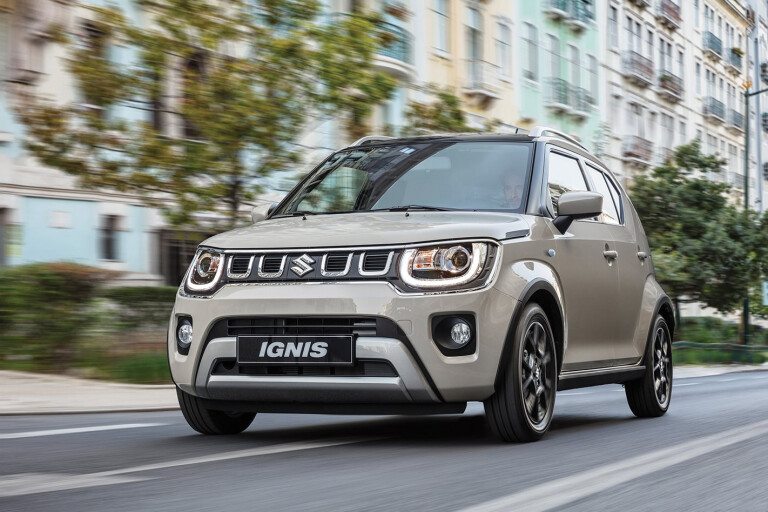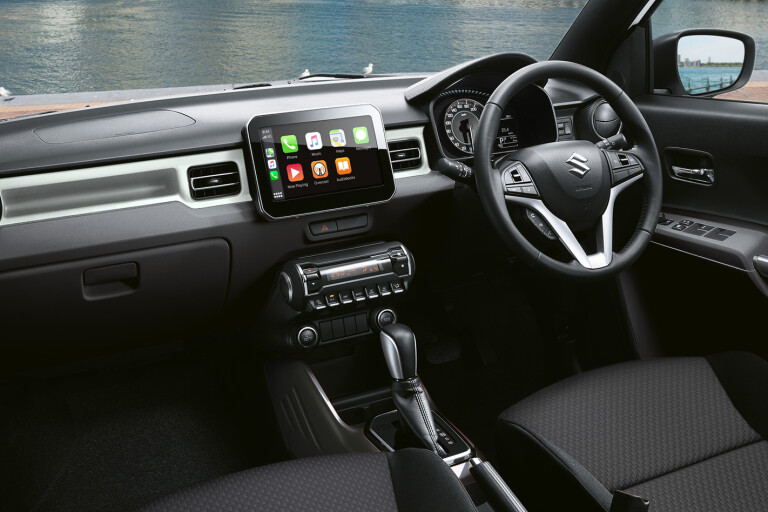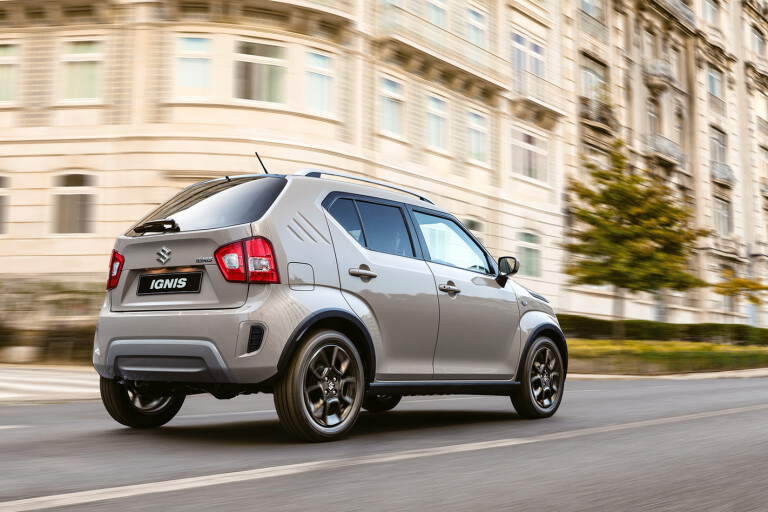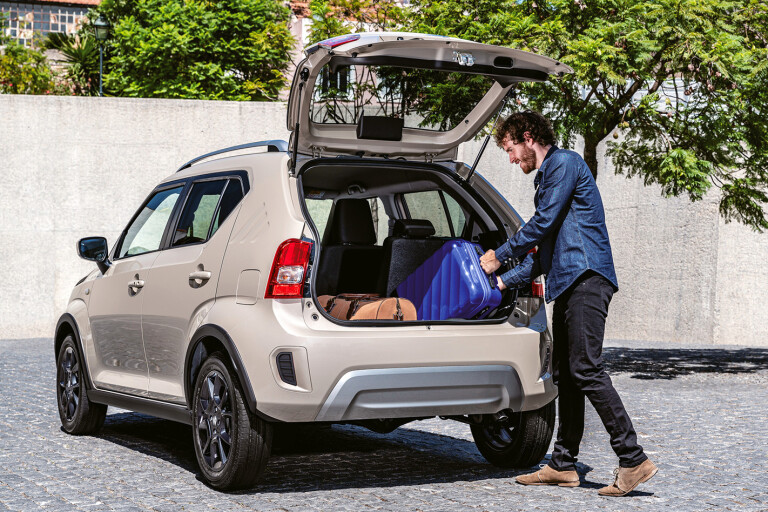
Score breakdown
Things we like
- Nippy, zippy, frugal, and fun
Not so much
- It’s tiny, and the GLX seats only four
What stands out?
Tiny dimensions make the fun-driving Suzuki Ignis exceptionally handy in the city, and its lightweight body helps it get along very nicely out on the open road – and without using much petrol.
The relatively tall, SUV-style body also means more headroom and legroom than you might expect, and for such an inexpensive car. The Ignis is well-equipped though it does lack safety aids such as autonomous emergency braking.

What might bug me?
Maybe, just maybe, the way the engine works when you accelerate hard in an auto Ignis. First, the engine speeds up, and then the CVT auto smoothly speeds up the car. It’s more effective, but some people prefer the feel of a traditional auto with distinct ratio steps.
The lack of active safety features such as autonomous emergency braking and lane-keeping assist, which has become the exception among new cars,
Otherwise, nothing that you wouldn’t notice in the showroom. What you see is about what you get, in an Ignis.
What body styles are there?
Five-door SUV-style wagon only. Ignis GLs seat up to five, while the more expensive GLX seats four.
Every Ignis drives only its front wheels.
The Ignis is classed as a light SUV, lower priced.
What features does every Ignis have?
- 7.0-inch central colour touchscreen.
- An MP3 compatible sound system with a USB input, Bluetooth connectivity for audio streaming, and at least four speakers.
- Reversing camera.
- Satellite navigation.
- Support for Apple CarPlay and Android Auto, so that you can display some phone apps on the touchscreen and control them from there (or by voice).

- Air-conditioning.
- Cruise control.
- Fog-lights.
- A leather-wrapped steering wheel, from which you can operate the cruise control, the audio system, and your phone via Bluetooth.
- Cloth-covered seats.
- A space-saver spare tyre (with speed and distance restrictions).
- Electronic traction control, which inhibits wheelspin on slippery roads.
- Electronic stability control, which can help bring a skidding car back under control. All new cars must have this feature.
- Six airbags: two directly in front of the driver and front-seat passenger; one alongside each front occupant to protect the upper body; and a curtain airbag down each side of the car to protect heads from side impacts.
The Ignis comes with a five-year, unlimited-kilometre warranty.
Which engine uses least fuel, and why wouldn't I choose it?
There is only one engine available in an Ignis, a 1.2-litre petrol four-cylinder that uses no more than 4.9 litres/100km on the official government test (city and country combined).
In the real world, the Ignis averages about 6.0 litres/100km – whether you choose a manual or an auto gearbox.
This small engine doesn’t produce much power. But because the Ignis is so light, it has more than enough performance to keep up with the traffic – both in town and on the open road.
The Ignis comes with a five-speed manual gearbox or a CVT automatic. A CVT, or Continuously Variable Transmission, adjusts the gear ratio incrementally rather than in the fixed steps of a conventional auto. That lets the engine run more sweetly and efficiently more of the time (provided the CVT is tuned well).
What key features do I get if I spend more?
The entry-level Ignis GL comes with 15-inch painted steel wheels (with silver plastic covers), the manual gearbox, and the features on every Ignis. Spend more and you can have the CVT auto.
Spend more again for the Ignis GLX and auto transmission is standard. You also get:
- Keyless entry and push-button start.
- Height-adjustable driver's seat.

- Climate-control air-conditioning that maintains a selected cabin temperature automatically.
- Brighter LED headlamps use very bright that turn on automatically in low light.
- LED daytime running lamps.
- Bigger 16 inches wheels made from fancier looking polished aluminium alloy – which does not need plastic trim.
Additionally, in a GLX the rear seat has a reclining backrest and the entire seat can be slid rearwards or forwards – so that you can maximise legroom or the luggage space behind. But unlike the GL there areonly two rear-seating positions.
You can also tailor the appearance of your Ignis, choosing from a number of bright, and contrasting, colours for the side mirrors, headlight and foglight surrounds, front grille centre, and inside the car the door grab handles and centre console surround.
Does any upgrade have a down side?
The bigger wheels on the GLX use tyres with a correspondingly lower profile, which don’t ride as comfortably as the tyres on the GL. They also cause the steering of a GLX to fidget and twitch more on bumpy roads.
The rear seat in a GLX accommodates only two people, and has only two child-seat tether points. (The GL can seat three in the back, and has three tether points.)
White is the only standard colour. All other colours, even white with a black roof, cost extra.
How comfortable is the Ignis?
More than anything else, the Ignis is a tiny car. That said, there’s a touch of the Tardis about it: it seems bigger inside than it looks.
The extensive use of white finish in the cabin (lower dash and door trims) helps give an impression of space. But there’s no getting away from just how narrow and short it is.

You can adjust the steering wheel for height but not reach. Even so, it is easy to find a comfortable driving position. Short drivers will appreciate the ability to raise the seat in a GLX – you can’t in a GL, and its default position is quite low in relation to the window line.
The dash on both models is dominated by a large and easy-to-use tablet-style touchscreen that controls all the ancillary functions aside from heating and ventilation.
While the GL manual is easy to drive, thanks to its positive gearbox and light clutch, an automatic Ignis is easier still. The CVT helps get the most from the little engine and lets you keep up with traffic with less attention.
Because the Ignis is so small, you can squeeze deftly through traffic and park in even the tightest spot.
What about safety in a Suzuki Ignis?
Every Ignis has six airbags, electronic stability control, and a reversing camera.
However, the Ignis does not offer active safety features such as autonomous emergency braking – which can apply the brakes on its own, to help you avoid a frontal crash that you have failed to see coming.
The Australasian New Car Assessment Program (ANCAP) has not rated the Ignis.

I like driving - will I enjoy this car?
You’ll probably be surprised just how much fun the Ignis is to drive – in the city and on trips into the countryside.
That’s largely because it’s so light – only about two-thirds the weight of most other cars listed as small SUVs.
The Ignis goes around corners like they are hardly there – whether it’s sharp city turns or more flowing country bends.

On the open road its progress feels surprisingly effortless. You want to sustain 110km/h up a long, steep, freeway hill? No problem, and without the engine feeling like it is working very hard. That’s thanks in part to the help it gets from the CVT.
MORE: Suzuki Ignis GL manual review
Although it’s a front-wheel-drive car designed with city use in mind – an SUV in name and shape only – the Ignis does ride an inch or so higher than more traditional city hatchbacks and it has a notably shorter expanse of body ahead of the front wheels.
That means there is less chance you’ll damage something if you venture onto bumpy and potholed country roads.
A word of warning however: You might not like the way a CVT adjusts the gear ratios seamlessly, rather than in steps like other automatics do. Some say it can feel like you’re in a manual car with a slipping clutch. When you demand a burst of speed – perhaps when overtaking a slow truck on the open road – the CVT allows the engine to spin hard almost immediately, holding it at a constant pitch as the transmission accelerates the car.
Doing things this way makes the Ignis quicker – but some people don’t like to feel the car changing speed while the engine is not.
How is life in the rear seats?
The rear seat is very narrow. Ignis GLs have a centre seatbelt and so can seat three, but all would have to be children.
The GLX accommodates only two in the back but it does so surprisingly well, thanks to the relatively tall cabin’s good headroom and decent legroom. Its rear seat (but not the GL’s) has fore and aft adjustment so that the legroom can be extended for tall passengers.
With either rear seat arrangement, there are two ISOFIX child-seat anchor points and at least two standard child-seat tether points. The GL has a third standard tether.
The Ignis is a good height for getting children in and out of car seats, and the rear door aperture is big for such a small car.
How is it for carrying stuff?
Let’s just say you can’t carry much stuff with all seats occupied. One small suitcase or a couple of soft overnight bags would fill the boot.
In a GLX you can add about 150mm to the boot floor (compared with a GL) by sliding the rear seat fully forward – provided you don’t need much rear legroom.

The rear seats in the GLX fold 50/50, while those in the GL fold 60/40. Neither folds flat, so the load space has two levels once the seats are folded. But you can squeeze in a fair bit more gear this way, for trips with fewer than four people.
Suzuki quotes a cargo volume of about 500 litres with both rear seats folded, loaded to the window line. That’s about the size of a big boot in a family sedan.
The Ignis has a one-piece tailgate and a low loading lip, which makes it easy to get luggage in and out.
Where does Suzuki make the Ignis?
The Ignis is made in Japan.
What might I miss that similar cars have?
That depends on what you think is similar. If you see the Ignis as a light SUV than its main rival is the Hyundai Venue, which comes with a suite of active safety features and broader range. The SUV-inspired Kia Picanto X-Line is similarly equipped to the venue and has similar visual appeal to the Ignis.
Another alternative would be Suzuki’s more expensive Jimny, which unlike the Ignis drives all four wheels, has dual-range gearing and can tackle very rough tracks off-road. But the Ignis is much better to drive on bitumen.
I like this car, but I can't choose which version. Can you help?
With its extra seat, more comfortable ride and nicer steering on bumpy roads, the GL is a better buy than the GLX. Much cheaper too. While some drivers might prefer the manual gearbox, the CVT does let you get the best from the engine with less effort.
Are there plans to update the Ignis soon?
The Ignis arrived in January 2017 as a new design.

The Series II update arrived in the middle of 2020 added nothing by way of equipment changes but brought a fresh look with a newly designed front bumper, rear bumper and front grille. Three new colours, Ivory, Khaki and Black, were also introduced.
Don’t expect a new-generation Ignis before 2023.
Score breakdown
Things we like
- Nippy, zippy, frugal, and fun
Not so much
- It’s tiny, and the GLX seats only four

COMMENTS